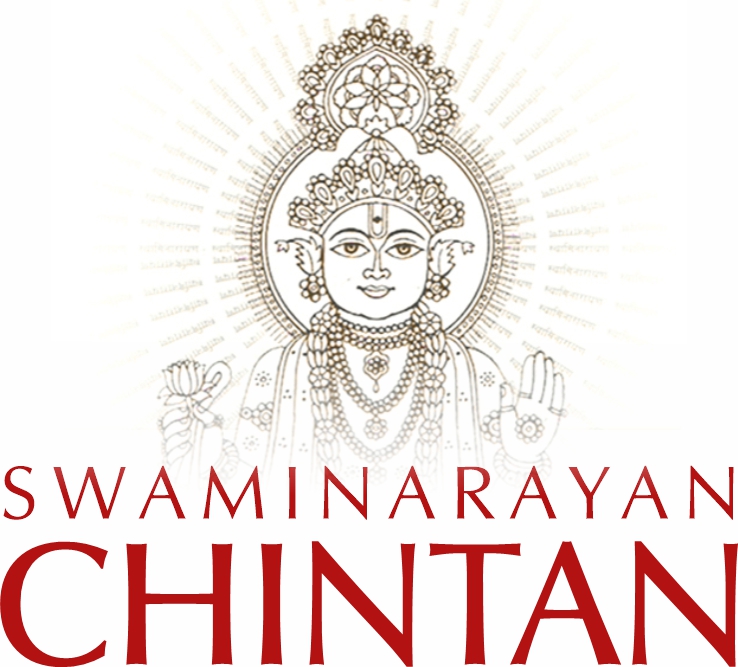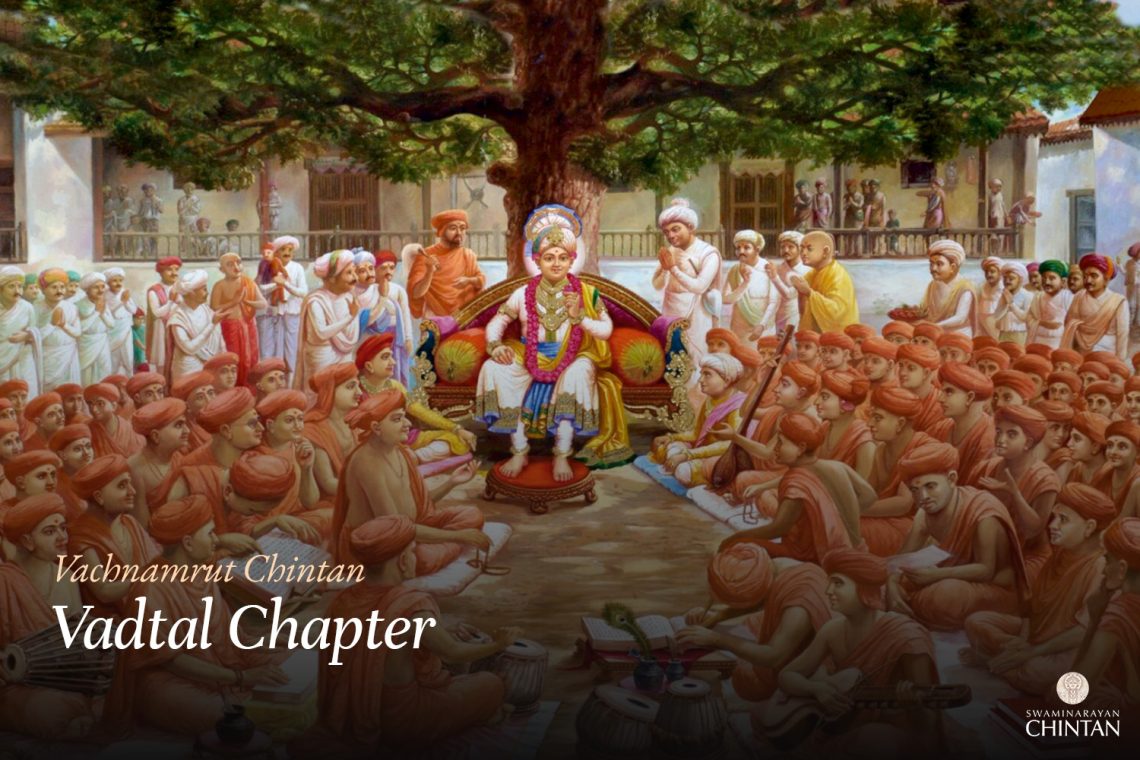Central Insights:
- The teachings that a member of the holy fellowship must know.
Key Points:
- The customs of the Sampraday (religious fellowship).
- The lineage of gurus.
- Authoritative scriptures in the Sampraday.
- Rules for all.
- The form of Bhagwan.
Explanation:
In this Vachanamrut, Shreeji Maharaj first posed a question to the senior Paramhansas: “What are the teachings a Satsangi (member of the holy fellowship) must necessarily know?”
He then answered Himself, explaining that one must know the customs of our Uddhav Sampraday (the religious fellowship established by Uddhav). A Sampraday is defined as a tradition where knowledge regarding the Paramatma (Supreme God) and the welfare of the soul is preserved and transmitted. This tradition includes an entry process through initial initiation, known as Diksha, whereby the Kanthi (sacred necklace) is tied, symbolizing surrender to Maharaj. This initiation is generally performed by Santos and occasionally by Haribhaktas (devotees). Through this ritual, one is considered to have taken refuge in Maharaj. Sins prior to surrender are forgiven by Bhagwan, and if one continues to uphold the codes of conduct without accumulating further sins, then Maharaj Himself will come to guide that soul at the end of life.
Nishkulanand Swami says:
Mārā janane atakāḷe jarūr māre āvavuṁ,
Birudhu māruṁ na badale e sarve janane janāvavuṁ.
During my final moments, Maharaj will come without fail, He will uphold His promise to all.
Additionally, if a devotee’s affection for Maharaj increases over time, they may receive a special initiation (Maha-mantra Diksha) directly from the Acharya (spiritual leader), including the Mahamantra. Such a devotee then lives constantly devoted to Maharaj, dedicating all activities and living a life oriented around Bhagwan.
Another aspect of the Sampraday’s customs is the Upasana (devotional worship) of Sakar Bhagwan (Definate form of God). Knowing these customs allows one to grasp Acharya Shuddhi (purity of conduct). The second essential point is knowledge of the guru lineage. Maharaj explains, “How so?” Ramanand Swami was an incarnation of Uddhav and had attained direct Bhagavad Gnan (knowledge of God) through Bhagwan Shree Krishna. Even so, he accepted Vaishnav Diksha in the region of Shreerang Kshetra from Ramanujacharya, establishing a lineage that extended through Lakshmi to Narayan. In turn, Maharaj became Ramanand Swami’s disciple and established the Acharya tradition in the Dharmakul lineage, which ensures continuity and purity of the teachings.
Thirdly, one must know the authoritative scriptures in the Sampraday. According to Maharaj’s instructions in the Shikshapatri, the eight authoritative scriptures are: Ved (Vedas), Brahma Sutra (Vyas Sutra), Shrimad Bhagwat, Vishnu Sahastranam (the Thousand Names of Vishnu), Gita (Bhagwad Gita), Vidur Neeti, Vasudev Mahatmya, and Yagnavalkya Smruti. Nonetheless, Maharaj emphasizes in the Shikshapatri and Satsangijivan that these scriptures must be interpreted in alignment with Sampraday texts, and thus we should primarily rely on Shikshapatri, Satsangijivan, Vachanamrut, Dharmamrut, and similar texts. If any point is unclear or incomplete in these, the other primary scriptures may be referenced. Fourthly, one must understand the regulations that apply to all in the Sampraday. This includes the rules Maharaj and the great Santos have established for Acharyas, Brahmacharis, Sadhus, and Satsangis (devotees), so they are well-understood and followed without doubt.
The fifth essential teaching is the knowledge of our Ishtadev (beloved deity) and His divine form. This includes an understanding of Bhagwan’s divine abodes—such as Badrikashram, Shwetdweep, Golok, Vaikunth, and Akshardham—as well as His attendants, such as Radha, Rama, and Arjun, through which various divine forms are manifested. In His divine abode, Bhagwan’s own form is a divine Sakar Murti (embodied form), always two-armed, and resplendent as a radiance. Understanding His form, nature, qualities, powers, and majesty is essential. One must also grasp the methods of His incarnations as taught in the Gita and Bhagwat, as explained by Vyasji, the supreme authority of Ved and Upanishad interpretation, recognized as Bhagwan Himself. If there is any ambiguity, one should reference Ramanujacharya’s commentaries and explanations.
Vyasji exalted Shree Krishna Bhagwan above all, emphasizing that all souls who form any connection with Shree Krishna are elevated beyond the Gunas, or material qualities. Therefore, it is incorrect to call Bhagwan “purely Sattvik”; Bhagwan’s form is truly Nirgun (transcendent) and divine. We should also understand Maharaj’s form as the source of all incarnations, powers, and manifestations.
Finally, one should not distinguish between Bhagwan’s attendants or His abodes. Regardless of which attendant or which place Bhagwan is present, He is eternally the same, without variation. Similarly, it is inappropriate to imitate Bhagwan’s actions, but one must act according to His teachings.
Glossary
| Uddhav Sampraday – The religious fellowship established by Bhagwan Shree Swaminarayan |
| Diksha – Initiation A formal spiritual vow or ceremony leading a seeker towards Bhagwan. |
| Kanthi – Sacred Religious Thread Devotees wear on neck A double-threaded rosary worn by initiated devotees as a sign of their commitment to Bhagwan and their surrender to Him. |
| Acharya Shuddhi – Purity and decorum upheld by the Acharya lineage Reflects the sanctity and code of conduct passed through the Dharmakul leadership. |
| Guru Parampara – Lineage of spiritual preceptors The succession from Ramanujacharya to Ramanand Swami to Shreeji Maharaj, then to the Acharyas. |
| Satsangijivan – The Sacred Scripture of Swaminarayan Sampraday The sacred Text that depicts the divine pastimes of Bhagwan Swaminarayan and describes the Dharma of saints and satsangis. |
| Shikshapatri – Sacred Scripture of Swaminarayan sect written by Bhagwan Swaminarayan Himself containing Essence of all the Vedic Scruptures |
| Sakar Murti – Divine embodied form of Bhagwan The physical form of Bhagwan, often with specific features, such as two arms, which is revered by devotees. This form is considered divine and is distinct from ordinary human forms. |
| Akshardham – The eternal supreme abode of Bhagwan Swaminarayan The divine realm where Bhagwan Swaminarayan resides along with Akshar Muktas (Divine Liberated Souls) |
| Ishtadev – Chosen deity The personal deity or form of God that a devotee worships and meditates upon, often chosen according to individual devotion. |
| Ramanujacharya – A Vedantic Philosopher & Sage |
| Vaishnav Diksha – Initiation into the Vaishnav tradition A form of initiation emphasizing devotion to Vishnu or Krishna, received by Ramanand Swami in Shreerang Kshetra. |
| Mahamantra – Received through special diksha directly from the Acharya as an expression of spiritual maturity and surrender. |
| Dharmakul – The divine lineage of Dharmadev’s family The family established by Maharaj for the propagation and sustenance of dharma and Upasana in the Sampraday. |
| Satsangi – A member of the Fellowship Satsang One who has accepted initiation and follows the commands of Shreeji Maharaj, saints, and scriptures. |
| Nirgun – Beyond the three qualities of Maya |

